Your cart is currently empty!
Blog

Most Interesting Thing One Could See in Nepal
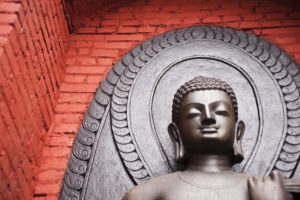
Buddha in Nepal Nepal: Land of Mysteries
If you are traveling to Nepal, there are so many things that you should know so that your subconscious will be prepared to deal with every improbable encounter which may befall you. Social norms set by the oriental religions like Hinduism and Buddhism, you can feel the aura of mysticism around the temples like Pashupatinath and Swayambhunath.
Don’t freak out seeing the scooters and bikes running like madmen on the dusty street, that is commonplace. And, most of all, if you happen to bump into an elderly woman joining two palms and saying “namaste” (which happens a lot), be cordial enough to reply here with the same gesture; it’s the way Nepalese greet the fellow human. You can also see different statues, wood carvings and temples and also sarangi playing in the street.
Whenever I talk with the foreigners traveling in Nepal, there are few things, which they find kinda unusual, which aren’t necessarily bad. Being one of the developing nations in the world and recently crawling towards the path of democracy, there are so many aspects of life that are still backward compared to life in the west. Here I have presented a few unusual things you might come with vis-a-vis, during the travel.
Worship of living goddess:
Also known as “Kumari”, it’s the century-long Hindu and Nepalese Buddhist tradition of worshipping the virgin which is considered to be the manifestation of cosmic power. Widely celebrated in Kathmandu valley, Kumari resides in an abode known as “Kumari Ghar”. She will be displayed on different occasions, commonly called “Jatra” in the valley. Surely, this tradition may appear as a bit of surprise for you, it’s a sacred ritual for the castes like Shakya and Bajracharya.
The sacredness of Cow:
The cow is taken as a sacred animal in Hinduism as it represents the goddess Laxmi (Hindu Goddess). During Tihar, also known as Deepawali, one of the two largest Hindu festivals in Nepal, cows are worshipped. But most of the urban streets are often encroached by stray cows which adds further problems in traffic management. So, don’t go “ holy cow!!”, if you happen to notice a lazy cow strolling in the middle of the road, it is common.
Jostling traffic:
Riding a bicycle on the roads of Kathmandu is way too scary that there’s an unspoken code “ ride on your own risk”. And talk about the endless motorcycles and scooters. These two-wheelers outnumber the public vehicles and cars which create such a mess during peak hours. Though the traffic police ( yeah, we have traffic cops, strange, right?) brings out so many plans to curb the problems, old habits die really hard.
Menstrual cycle means a four day off-limits:
Surprised? Well, most people find it perfectly plausible in Nepal. Any girl or a woman during her period is barred from all religious activities for four days. Also, she is not allowed to cook and serve the family. Even though the tradition is slowly fading, still it’s in practice in most households.
Of porters and Rickshaws:
Kathmandu, unlike most of the capitals, isn’t well managed; one of those Nepali ways of living is depicted by the presence of porters around the market carrying wardrobe, refrigerator or you name it. The tradition of the porter system dates way back and can be seen in the photographs taken by Tony Hegan during the 50s. In addition, you can travel around Thamel, downtown Kathmandu, in a rickshaw, which is pretty fun, I guess.
Cops, they don’t carry guns:
Cops are often seemed to patrol in the alleys of Kathmandu with bamboo sticks unlike the cops in the US or in most of the countries. In a way, it’s pretty secure to wander freely around the valley and cops can be really helpful in many ways.
Nepal has a triangular national flag:
Nepal is the only country in the world having a non-quadrilateral flag. The triangular flag of Nepal depicts the mountain range and the pagoda style in the temples. The blue boundary shows peace whereas the crimson red glorifies the Gorkhali history. The celestial bodies Sun and Moon symbolizes the permanence of Nepal.
Bungee jump:
Though bungee jump is practiced in most countries, the thrill of jumping towards the mind-blowing gorge of Nepal is an experience not easily subdued. If you are traveling Nepal for adventure, bungee should be your first priority as they feel will remain fresh in the pile of your memories. The famous bungee jump is carried out in Nepal by “The Last Resort” in Bhote Koshi gorge. Also, you can experience bungee in Pokhara, the tourists’ paradise.
Paragliding:
I cannot label paragliding as one of the unusual things in Nepal but by far it’s one of the bests in the world. Who wouldn’t love to savor the gorgeous aerial view of Mt. Fishtail and the bird-eye view of magnanimous Fewa lake and Pokhara valley? Operated by trained pilots, domestic and international, paragliding in Nepal offers such a deal, not even Cersei Lannister would dare to refuse.
Cultural Diversity:
It amazes, even me, a typical Nepali guy when I observe so many cultural practices within a small area of 147, 181 sq. km (well, it’s the area of Nepal). And probably it’s a major fascination, the tourist gets on traveling Nepal. The presence of Buddhist shrines like Boudhanath and Swayambhunath along with the Hindu temples in Kathmandu valley exemplifies the cultural diversity. The celebration of different festivals like Dashain, Tihar, Chauth, Loshar, Udhauli, Deuda, Maghi, and so many local Jatras depicts the century long diversity in Nepal.
Hope you all enjoy it.
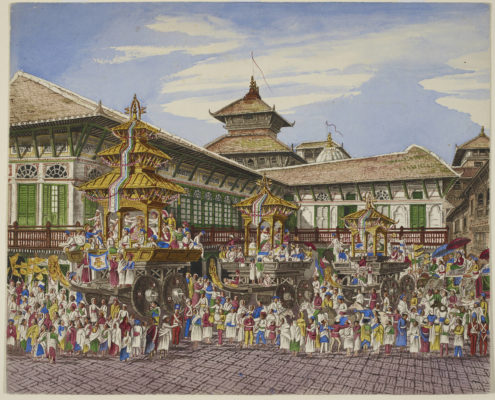
Nepali Arts

Reflecting Nepali culture, undergoing transformations that were considerably influenced by religion, politics, social conditions, events such as natural disasters, and so on, Nepali Arts has evolved immensely over the eras.
It is believed that Nepali art and culture were parallel in existence, however, the oldest evidence that has been traced belongs to the fourth century i.e. The Lichchhavi period which is considered to be “The Golden Age Of Nepali Art”.
Over the centuries, the environmental factors in the society, nation, and the state of the artist have affected the subject of arts. Historical sculptures and artworks were mainly religious, mystical, and symbolic. Whereas, the subject of artworks of the periods with political revolution such as the Rana Regime was based on secularism, realism, etc.
Later, after the fall of the Rana regime, artists practiced impressionism, fauvism, expressionism, abstractionism in their artworks. Besides the internal issues, western culture and practices also inspired artwork in the past. Even today, artists practice symbolism, abstractionism, impressionism, and use the various metaphorical symbol with hidden meanings and messages.

Historically, architectural feats and structures, wooden carvings, manuscripts, mandala, wall paintings, portrait painting, were some of the major artworks. The forms of art in context with Nepal are innumerable, the artworks can be classified in the following ways.:-
Paintings:
In the past, paintings were mainly done in manuscripts, walls, wood, copper or other metal plates, or cloth. Local materials such as minerals, plants, soil etc were used for extracting colors. Thangka Paintings, Mithila paintings, Pauwa paintings, are some examples of Nepali paintings. These days paintings are mostly done in canvases and are influenced by western culture.
Architecture:
The intricate linings of the wooden windows and doors of a temple, the complex geometry of a stupa, the prayer wheels, are examples of architecture. Architectural art can mainly be seen in religious sites or historical areas. Architecture has had major shifts according to the eras and revolutions that occurred with time.
Sculpture:
Artists mainly made use of bronze, granite, sandstone, limestone, for sculpting figures of gods, leaders, and rulers. The statues of gods, various rulers can still be seen in historical areas.
Pottery:
Traditionally a lot of utensils and household materials used by Nepalese were made out of molded clay such as pyala, gamala, gyampo, gagri, diyo, lamps, flower vases and so on.
Besides the form of art listed above, local songs, traditional musical instruments, traditional dances also reflect Nepali art. Art accentuates looks making things look more appealing to the eye.
More importantly, Nepali art emphasizes the divinities of religion and the connection of man with God and nature, it symbolizes various life processes and stages such as birth, youth, death in the form of intricacies. Arts act as historical evidence and symbolic representation for the rich history that we possess.
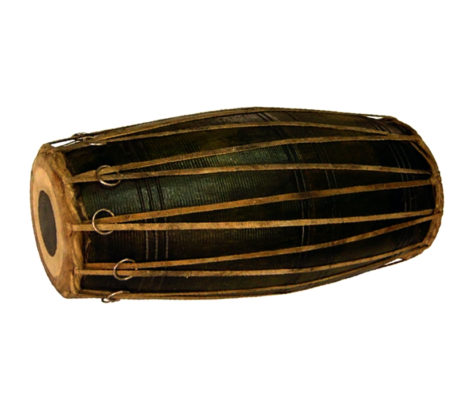
Madal | Folk Musical Instruments
[product_embedder_blogs product_id=”858″]
Madal, one of the most popular double-headed hand drums played in Nepalese society and has there been from the early 20th century.
The word Madal has been formed from the Sanskrit word “Mandala”. Madal being a national musical instrument of the country is the essential element of the Nepali folk music industry. Making it as a lead instrument many songs has been prepared by different Nepalese folk song singer.
It has a vital role in forming the bonding of love between family crew and friends and society. It has taken the hearts of people from the hilly area of Nepal and its associated region.
When is Madal played?
Madal is played generally in the festival Dashain, Tihar, and other festivals among the different tribes of Assam, Magar community. Different tribes play Madal on different occasions. Hiking, camping, get together with friends and family are some areas where we can listen to and enjoy music.
Kids, youth, and olds love dancing on the beat of this instrument. It is really creative drum which makes a nice sound and is very fun to listen to. Accompanied by cool tones and really fun to use it. Easy to carry. You can jam up with any musical play. This is a cool percussion instrument and would really enjoy it playing it now. Not only Madal, but people also enjoy the music of sarangi and meditating the healing sound of singing bowls.
What is Madal Body made of?
Earlier, its body was made with the burnt clay but nowadays it is made of wood also. The body of Madal is exact as a cylinder shape leaving hollow at both ends. One end of the structure is smaller named “Daayan” and the next ends in bigger named “Bayan” as compared to another.
The hollow structure formed from the wood is called “Ghar”. The ends of the hollow structure are then covered with the skin of either goat/ox/monkey/buffalo on both sides. It is like the shape of the dish, round in structure.
On the top of that round structure dish we see a black spot layered, this is known as “Khari”. It is made up of iron fillings, flour, and egg which provide it to be black in color and a nice paste to stick to the skin for a longer period of time.
“Khari” adds weight to the skin and helps in producing additional sound. This also acts as a sound controller for the drum. The skid plate on both ends is attached with leather rope and round rings tightly on a continuous loop around the body of the drum.
Why is the additional rope attached to Madal?
An additional rope is added in order for the drum to fit on the performer’s body on a horizontal position either of the waist or on the knees making it comfortable to play with both hands. Once preparation is done tuning is made by leather strands and adjustment of round rings up and down on the body of the drum.
You can buy Madal in our online store. Your dream of playing can just be fulfilled by adding it to your cart and making an order of this cool stuff in simple steps. It can be ordered in different sizes as per your choice.
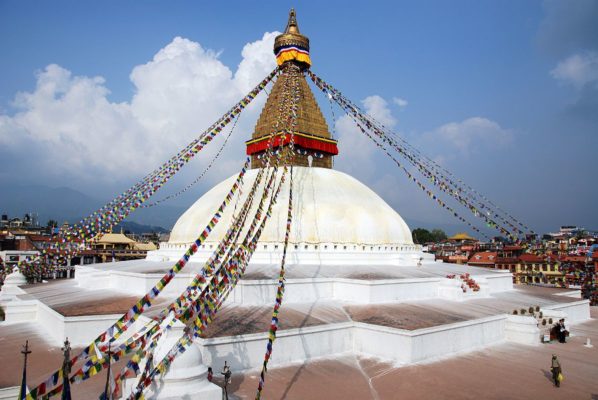
Nepal Tourism 2014, 2015 and 2016
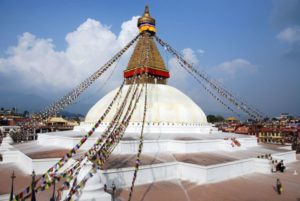
Nepal’s tourism experienced a dramatic turnaround last year after being hit by the twin disasters of a devastating earthquake and crippling trade embargo in 2015.
Foreign tourist arrivals to Nepal jumped 39.71 percent to 753,002 in 2016, boosted by robust visitor growth from India, China, the US, the UK and Sri Lanka, according to the statistics of the Department of Immigration.
However, 2016 arrivals are still 4.69 percent down from 2014 when the country welcomed 790,118 foreign visitors. The tourism boom is expected to continue in 2017 and remains a major growth driver for the economy even as the industry sees low overseas promotional activities.
October, November and December have been the most productive months for the industry, accounting for nearly one-third of total arrivals.
“It’s a dramatic growth. The industry is returning rapidly to its pre-earthquake growth level,” said Kedar Neupane, director general of the Department of Immigration. “The tourism boom is expected to continue in 2017 given a level of promotion by Nepal in the major source markets.”
He said that if the government, Nepal Tourism Board and private sector conducted aggressive promotional activities, this year could be an extraordinary year. “We can expect 1 million tourists in 2017 considering the current environment.”
Neupane said that Nepal could see a boom in Chinese arrivals this year following the move by the Chinese government to encourage travel to the country. China has announced Nepal Tourism Promotion Year 2017 in a bid to encourage its citizens to visit the Himalayan republic, according to the Nepal Embassy in Beijing.
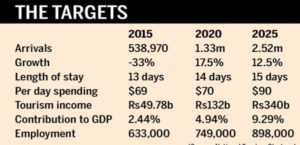
“The industry carried out massive marketing activities in major source markets after the earthquakes, leading to a massive recovery,” said tourism entrepreneur Basant Raj Mishra. “The arrival of foreign volunteers as well as conferences held by I/NGOs in Nepal last year propelled growth.”
Suman Pandey, chairman of the Pacific Asia Travel Association (PATA) Nepal Chapter, said that 2017 looked promising; but the crumbling Tribhuvan International Airport (TIA), Nepal’s only international aerial gateway, could be a major setback.
“The hospitality industry in Nepal can accommodate more than 3 million tourists, but the airport is already choked with capacity constraints even though arrivals are way short of the one million mark,” he said.
TIA is currently served by 28 international carriers, and it has announced that it cannot accommodate more flights. “What does this statement mean? Of course, Nepal has become an attractive holiday destination for travellers, but TIA will remain the main obstacle to the growth of the industry.”
Nepal received a lot of media exposure following the earthquake which has aroused tremendous interest among potential travelers.
The world’s leading travel guide Lonely Planet has named Nepal the world’s ‘best value destination’ for 2017. Likewise, Nepal’s Langtang region has been featured in The New York Times ‘52 places to go in 2017’ list.
Nepal has also appeared in the January travel issue of chinadaily.com.cn. “Nepal remains a fabulous choice for budget-conscious travelers, whether it’s the country’s world famous trekking routes or the wildlife in the southern region. Travel costs per day are as low as $50 on average,” it said.
A breakdown of arrivals by market shows Indian travellers at the top of the list. Arrivals from the southern neighbour reached 118,249 last year, up 57.40 percent. Chinese tourist arrivals jumped 55.26 percent to 104,005. Travel trade entrepreneurs said that Chinese arrivals did not increase as expected last year as the key entry point,
Tatopani Customs in Sindhupalchok, was closed after the earthquake. However, Rasuwagadhi has emerged as an important surface route with 23,452 Chinese visitors entering the country through this point last year.
Meanwhile, visitors from the US, Sri Lanka and the UK jumped 25.67 percent, 29.64 percent and 55.71 percent respectively.
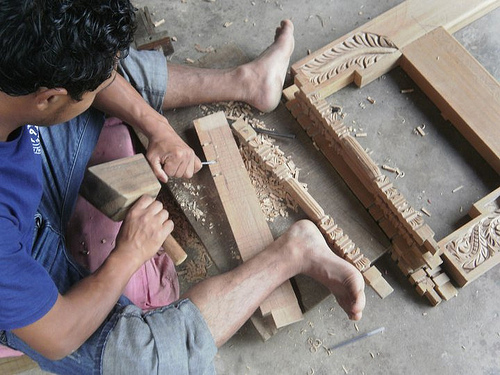
Earnings from Handicraft Rises by 19 Percentage
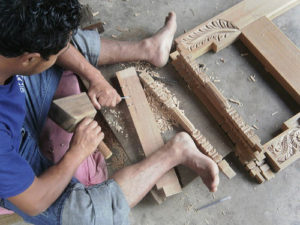
a wooden artisan showing is mettle with mallet Export earnings from handmade products surged 19 percent in the first four months of the current fiscal year, thanks to sustained demand from markets like China, the US, and Europe. Nepal’s handicraft industry is on the recovery path after suffering a massive hit from the earthquake and trade blockade last year. Statistics released by the Federation of Handicraft Associations of Nepal (Fhan) show that Nepal exported handmade products worth Rs1.98 billion during the period mid-July to mid-November Shipments amounted to Rs1.67 billion in the same period last year.
Fhan President Dharma Raj Shakya said that the handicraft business that was adversely affected by last year’s earthquake and trade blockade was back on track. According to him, business dropped last year due to a short supply of raw materials and manpower. “Based on current export trends, revenues are expected to touch Rs5 billion this year,” said Shakya. In 2015-16, Nepal exported handicraft goods worth Rs4.78 billion. Of the 25 major handicraft and unique items, earnings from felt products posted a growth of 69 percent with exports jumping to Rs559.62 million from Rs331.69 million. Shakya said that outfits and accessories made of felt had been attracting many foreign buyers in recent days. Felt products are mainly exported to the US and Europe. Similarly, metal crafts accounted for the second-highest export earnings.
Nepal’s export of metal crafts surged 30 percent to Rs465.46 million. These products are exported mainly to the US and China. Likewise, export earnings from glass products surged almost three-fold to Rs81.78 million. Decoration items and smoking devices are among the popular items in the segment. Exports of beads also increased to Rs57.96 million from Rs38.73 million. However, exports of pashmina products, handmade paper, and silver products declined during the review period. Export earnings from pashmina plunged by almost half to Rs156.98 million. Shakya attributed the fall to increasing exports of machine-made products. “As machine-made pashmina is cheaper compared to handwoven products, export values have declined,” he said. Shakya said orders for Nepali handicrafts had been coming from new markets like Mongolia and Vietnam. “Following a change in lifestyles in these countries, demand has increased.” Nepali handicrafts are shipped to 80 countries among which 30 are large buyers. Europe accounts for 43 percent of Nepal’s total handicraft exports, while the US accounts for 17 percent.

Story of Sabita Maharjan, an inspirational entrepreneur
Sabita Maharjan, a social entrepreneur, has been providing employment to hundreds of women in her knitting business.
She founded Kritipur Hosiery Industry in 2008 with the aim to uplift socially vulnerable and underprivileged women so they could be financially independent.
At present, Maharjan owns her own brand K-knitting, which has garnered much recognition for her products and hard work. She launched this new venture with the help of the Business Services Center (BSC).
She has also become the inspiration for Women Empowerment in Nepal.
K-knitting produces a range of items like woolen gloves, caps, mufflers, hats, pullovers, woolen jackets, sweaters, scarves, and socks. Some of her items are showcased at Kalanki Knitwear and some are waiting to be displayed on the premises of popular restaurants in Kathmandu.
In 2011, Sabita and her K-Knitting family started working with Sherpa Adventure Gear and after two years of product and quality training, their items were finally showcased.
In 2015, the Kirtipur Sweater Jacket led the Sherpa Adventure Gear to the ISPO Gold Award. The International Fashion Textile Trend Consultant (GBR) said the sweater was a perfect combination of tradition and technology because each piece was hand-knitted in Nepal, using 100% lamb’s wool, and a tradition that had withstood centuries had been maintained. As for the technology, the sweater was lined with PrimaLoft Silver Insulation to add warmth and softness.
This year, Maharjan plans to open six more branches and a training center where women would be provided hands-on training for knitwear and handicraft items.
Her business, which she started with 72 knitters, has now grown to support 300 women from different parts of the country.
The women, who are working with her, now have gained confidence and necessary skills to support themselves and their families.
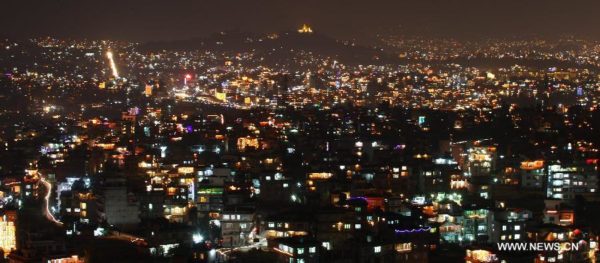
Tihar | Festival of Lights
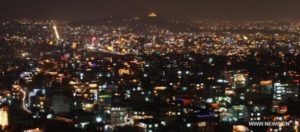
Tihar- Celebration of Lights. It is regarded as the second popular festival in Nepal which is celebrated by almost everyone as it is also known as “Festival of Colors”. As it occurs just fifteen days after Dashain, September- October can be taken as the festive season in Nepal. Legend has it that, Dipawali, which literally translates to lighting the lamp, is celebrated to welcome Rama and Laxman, home ( Two Hindu demigods) as they return after defeating Ravana ( Evil king Of Lanka). Also, this festival is popular in the sense that it strengthens the bond between Sisters and brothers. Tihar is also known as Yama Panchak (Five days of Yamraj, the god of death) as there are five days of celebrations, namely:
- Kaag Tihar ( Crow Tihar)
- Kukur Tihar ( Dog Tihar)
- Laxmi Puja(Laxmi Tihar)
- Govardhan Puja
- Bhai Tika
All the celebration days of Tihar have its various myths, legends, and beliefs and every day starts with the offering.
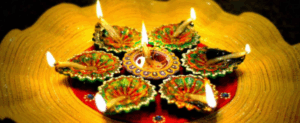
Kaag Tihar (Crow Tihar):
This is the first day of Tihar during which crows are revered and given sweets and different food items. According to Hindu scriptures, crows are considered to be the messenger of Yama, the death god.
Kukur Tihar (Dog Tihar):
The second of the Tihar is celebrated by offering garlands, tika, and different sweets and food to dogs. Considered as the gatekeeper of god Yama, the Hindu devotee takes this day for the veneration of the dogs.
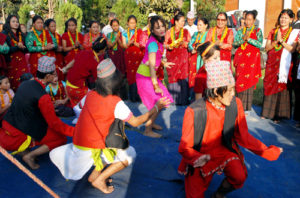
Gai (Cow) Puja/Laxmi Puja:
In Hindu myth, Laxmi is regarded as the goddess of wealth and prosperity. So, on the third day of Tihar, Laxmi Puja is celebrated and on the same day, people crack fireworks and Perform Deepawali (Lighting of Lamps) all over their houses and abodes. During the same day, Cow, which is taken as the incarnation of Laxmi is also worshipped and given sweet dishes.
After the puja, girls gather in groups wearing the cultural dress and traditional jewelry and play Bhailo the whole night, collecting money and giving blessings to the families.
Goru (OX)/Govardhan Puja:
It marks the fourth day of the Yama Panchak on which farmers venerate the oxen. Legend has it that this day is also celebrated to mark one of the superheroes of Hindu myth, Hanuman. Goru puja, worship of Oxen, Gobhardan puja, and Maha puja are done on this day for a healthy and prosperous year ahead. From this day, the boy’s group, familiar to Bhailo but called Deusi is played.
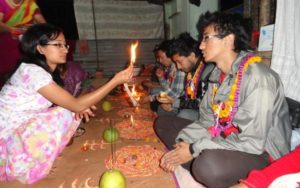
Bhai Tika:
The fifth and the final day is known as “Bhai tika”. This is undoubtedly the auspicious occasion of Tihar when the sisters put tika on the forehead of the brothers and share the gifts. This day stands as one of the important events to strengthen the bond between sisters and brothers. Also, the sisters pray for her brother’s long life. Mostly boys wear Dhaka Topi (Nepali Hat) on this day. Also, most of the sister gifts Dhaka Topi to their brothers.
I can’t ignore to look at the house decoration: decorated with lights, Rangoli, Diyo and candle lights at night, and also the flowers. You can see people of different ages making their group and playing Deusi and Vailo. Besides you can also watch people playing gambling and playing cards, swings, Langerburja, etc. Tihar is definitely one of the merriest making the beautiful festivals as you can see lots of smiles on each face having sweets and delicious food with colorful lights.
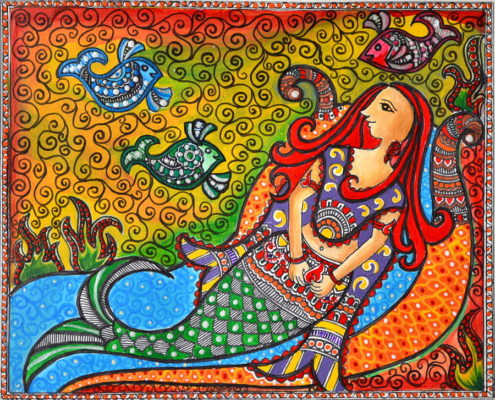
Mithila Arts
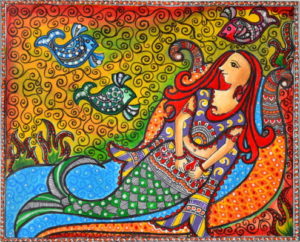
This art is a strict monopoly of the women of Mithila.They cover their courtyard walls in abstract images in brilliant colour, resembling in form and function the sand paintings of the Navahos. The art is a kind of traditional painting that reflects the natural environment including animals, people, life style, tradition and culture of the local people.
The art of Mithila is linked to religious ceremonies, particularly marriage and its consequence, procreation. Interspersed with the Vedic marital rites, with the Sanskrit chanting by the Brahmins, is a tradition controlled by the women and devoted to female deities Durga, Kali and Gauri. During marriage ceremony the bride and groom are pulled away by the women for their own ceremonies devoted to Gauri in which men other than the groom are forbidden. Gauri is the goddess to whom the bride has prayed since childhood to bring her a good husband. These ceremonies are performed in courtyards before painted images of the goddesses. The function of the paintings being ritualistic the art is very symbolic. The primordial energy of the universe is embodied in various female forms, both living women and Goddesses.
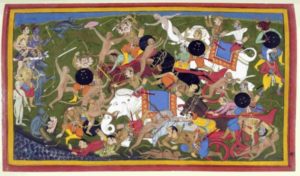
image source: wikimedia

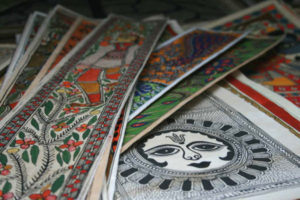
As the wedding ceremony is a special occasion in Maithili society, which is also known as “Kohabar” within thecommunity, a separate room is set and decorated tastefully with several arts for its celebration. This painting is done in the inner as well as outer walls of the Kohabar Ghar (honeymoon house). As a popular social practice, its main motto is to increase the sexual potency and fertility of both the bride and bridegroom. This special painting is drawn on the walls of the house in three places: the Gosaighar (special room for family god), the Kohabar Ghar (honeymoon room) and Kohabar-Gharak-Koniya (corridor or outside of the Kohabar Ghar).
These paintings are wonderfully depicted by the illiterate woman folk of Mithila, and are quite attractive to look at. They express their artistic sentiments and skills on various occasions. The outer walls of the Kohabar are decorated with the paintings of rural life such as a palanquin with its carriers, shady fruit trees like those of mango, banana, Kadamba and Ashoka. They also paint love-scenes of Lord Krishna with the gopinis and his constant companion, Radha.
Some common themes in mithila arts include the Snake goddess, a form in which snakes are worshipped at Nag Panchmi during the monsoons, a time when snakes abound. Durga astride her tiger is another common representation. Probably the most powerful symbolism is the one associated with Duragoman Puren. A single seed that is dropped in the pond produces many lotus flowers, an appropriate thought for the bride and the groom at the time of their wedding. Lakshmi, the Hindu Goddess of wealth, is a newer and common addition to the repertoire of Mithila symbolism. Among the male deities Ganesha, Krishna and Shiva are more commonly depicted. Trees, birds and animals are extensively used in combination with other ritual and religious paintings. Sometimes, rarely, one will see these alone without religious implication.
The painting tradition varies from caste to caste. The art of Brahmins and Kayastha is closely tied to religious ritual, as exemplified in the making of aripana.
To make aripana a woman grinds rice with some water into a paste called pithar. Dipping two fingers into the pithar, she makes graceful lace-like designs on the mud floor of her home or courtyard. She then dots the designs with red powder. Women have a repertoire of such designs that may be drawn for worship of the house deity or for rituals related to marriage or a particular full moon day. The arts of the women are transient. Rains destroy the mud and painted designs or in the spring during a New Year festival, paintings are covered over with mud.
Aripan: paintings of Mithila The Aripanas are drawn by various female members of the household, on ritually prescribed occasions, on the clean swept ground of the courtyards or inside the house.
The Aripan painting, derived from Sanskrit “ Alepan” (meaning “to smear”), is quite auspicious in the whole Mithila region. It basically refers to smearing the ground with cow dung and clay for ritual purification. Also known as “Mandala”, this art form comes into play on several religious occasions such as Brata Bandha (sacred thread ceremony), Chhatiyar (sixth day rites of a child after birth), Mundan (head shaving ceremony of a child), puberty, conception, initiation into learning, and marriage. Interestingly, this art is also practiced in various parts of India under different names like “Alpna” in West Bengal, “Mandala” in Rajasthan and “Rangoli” in Gujurat. In Nepal’s Bhojpuri areas, it is known as “Chaukapurna” while in Mithila, it is “Aripam’.
This Tradition of Aripan is found in Grihyasutra too. The Vastu Purusha Mandala is a schematic mental map, and the basis for nationalizing any site. It is not a measured drawing or a contour map, but a code that enables reading of the site and a resolution of its design. A piece of land, once assigned for a dwelling, becomes the Mandala within which the world of a man is organized. Its features become the Mandala, which in turn adopts its shape and terrain. The concept of the Vastu Purusha Mandala acts through a site without which it remains physically nonexistent, which means that an ordered field cannot exist without a field.
Aripan is drawn and depicted both for adornment and purification of a piece of ground. It is painted either on the main entrance gate of a house, or at thresh-holds and courtyards. Sometimes, it also finds place in the main residential room. Both young and old women are talented at this particular art form.
There are many kinds of Atipan art which are depicted and drawn for various purposes. One kind of Aripan is drawn on the auspicious occasion of Tusari Pooja in which young, unmarried Maithili girls draw it to get good husbands. Its duration is between Makar Sankranti and Falgun Sankranti. In this Aripan they draw a temple, the moon, sun, navagrah (nine planets and so on. Likewise, Sanjha Aripan, which is depicted in honor of Sandhya Devi (goddess of the evening) . And the whole cosmos are drawn and shown in the form of a temple. Panch Dev (five gods) and Shapta Rishis (seven sages) are also sketched in the shape of the lotus Aripan.Similarly, Sasthi-pooja-Aripan is painted when young girls start menstruation. This Aripan signifies the creation and destruction of the universe. The Gatra-Sankrant Aripan is the symbol of birth and death, whereas the Kojagara Aripan is drawn on the leaf of Makhan on the full moon-day of Aswin (September). Diwali Aripan, which is known in Mithila region as Sukha-ratri Aripan, is depicted to welcome laxmi, the goddess of wealth. And Swastik Aripan is painted for blessing the young generation.
Aripan art is cosmic in nature and playful in expression. It is a bright and beautiful art. The material applied in such art is a mixture of powdered rice and water, known as “pithar”. The women folk, dipping two fingers into the pithar, produce graceful geometrical diagrams with different designs on the mud floor of their housed and courtyards and at the thresholds. This art tells of the magnanimity of the mother goddess
In order to make it more adorning, the women also smear red powder on it. Moreover, three inner triangles symbolize gauri, the favorite goddess of the Maithil maidens.
The Aripanas are drawn by various female members of the household, on ritually prescribed occasions, on the clean swept ground of the courtyards or inside the house.
Ideally, the design of an Aripana should be revealed to the lady-artist as a result of meditation and general yogic experience.
In practice, the details of the various Aripanas are learned by girls from watching the work of their mothers, grandmothers and other female relatives and neighbors”.
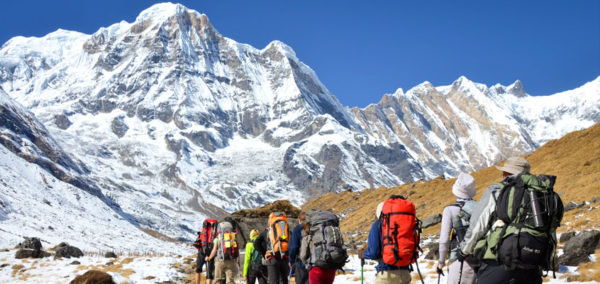
Nepal Trekking Season | Best Time For Trek in Nepal
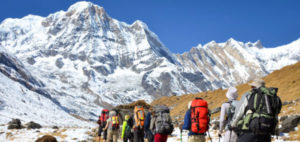
Nepal Trekking Season generally known best as two seasons after falls and after the winter. The following month mid of September to mid of December consider ever best season of trekking in Himalayas. During this period of months have pleasant climate condition not so hot and cold and visibility of mountain are crystal clear. There is another best season of trekking Nepal after winter when sun getting more warmer in spring time may trekkers to Himalayas can again enjoy comfortable climate condition. In spring season in Nepal many different types of flowers bloom both trees and ground and it is also the best time to climb up peaks for expedition.
Autumn (September-November)
Autumn season is considered as the best trekking season for the trekking in Nepal. September, October and November are fall in this trekking season in Nepal. During in this season offers excellent weather and tantalizing mountain views. Temperature is moderate, making it a good time for any trekking. The sky is generally clear with outstanding views. Occasionally short storms may dump considerable snow at high altitudes.
Winter (December-February)
Generally, the days are clear in winter season in Nepal. December, January and February months are cold days in mountain. In winter season in Nepal is usually snow fall in the higher elevations with risk winds and colder temperatures. Hence is ideal for trekking in the lower elevation. If you are looking for suitable and incredible scenery, this is a great time to Trek in lower elevations.
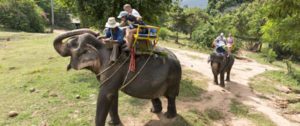
Spring (March-May)
Spring season in Nepal is also considered as the best season to do the trekking and mountain climbing. In this season offers different varieties of wild flora blossoming of the giant rhododendrons above 3000m and hunting paradise during this season, which makes higher altitude trekking more comfortable and interesting. It is mildly warm at lower elevations and quite moderate temperature at higher elevation over 4000m, which provides spectacular and excellent mountains View. March, April and May months are fall in this trekking season in Nepal.
Summer (June-August)
June, July and August months are main rainy season in Nepal and involves monsoon with heavy rainfall which makes trekking conditions unfavorable.This season is ideal time for Trekking and tour to Tibet however, in some Trekking regions of Nepal connecting to Tibet and desert parts of Nepal like Mustang, Nar-Phu valley and Dolpo regions are best season to do trekking which is summer trekking a great alternative behind the Himalayas rain shadow area.
Some Glimpses Of Trekking

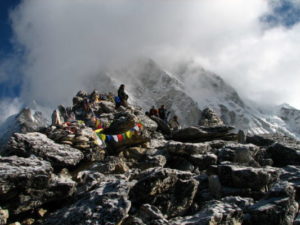
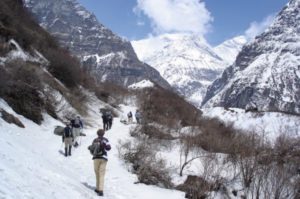
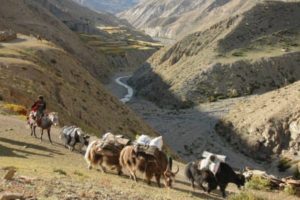
mage Source: Wikimedia and freegreatpicture 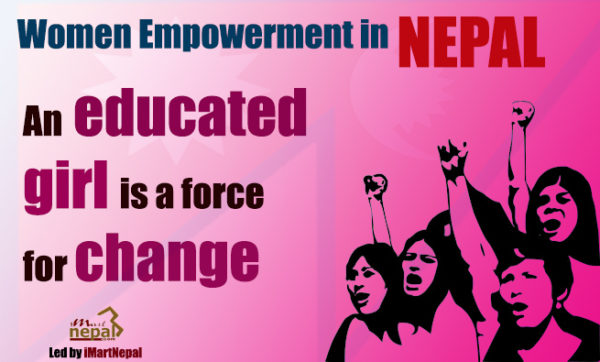
Status of Women in Nepal

A single statement applicable to all the women in Nepal cannot be made as different groups of women enjoy different status. For instance, Hindu women and the women belonging to indigenous ethnic groups have different rights and suffered from different modes of oppression. The latter groups enjoy more excess and control of researchers. Indigenous women have relatively a higher degree of social mobility, and posses freedom within the private sphere.
They are, however, unable to participate in the public realm due to the dominant ideology of culture being practised. Dissimilarly, Hindu women have no autonomy within private sphere, but enjoy limited positions in the public sphere. Their oppression stems from the concepts of hierarchy, the caste system, traditional thought about food, and the high value of chastity. Although the women belonging to different caste, religion and culture have different status, one thing is certain that they are being oppressed with respect to economic , socio-cultural, political and legal status which cannot be analysed into isolation because each is intrinsically tied to the next. But for the sake of clarity, each category is discussed separately.
Poverty
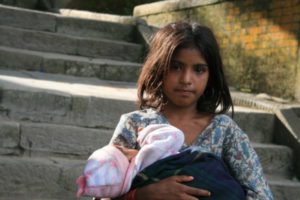
Let’s discuss economic status. The dominant Hindu religion and culture have popularized a belief that women should be dependent on males for income from cradle to grave. Men are considered the sole breadwinners of families; and women are viewed only as domestic maternal. Women’s work is confined to the household. Their responsibilities are thought to include cooking, washing, collecting fuel and firewood, fetching water, engage in agriculture, maternity, and service to males and other family members. Although their work plays a vital role, it is normally left uncounted.
Women involved in wage-labour
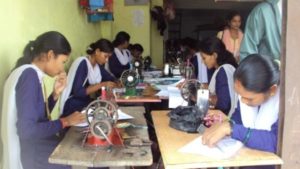
The work load of Nepalese women is immense. They work about 16 hours everyday. Nepalese women are mainly engaged in agriculture work, carpet industries, and wage-labour activities. Furthermore, Nepalese women are compelled to resort to prostitution and to be sold as commercial sex workers. Because of modernization, their workload has certainly increased. Thus, they are now forced to perform triple roles: that of mother,of a traditional wife and of a community participant. Generally Nepalese women have much less access of industrial credit, both an individual and household enterprise levels irrespective of ecological regions, urban or rural areas and ethnic or castes. Complicating economic disparity is the increasing feminization of poverty. To remedy this situation, women would need full economic rights.
Dowry system
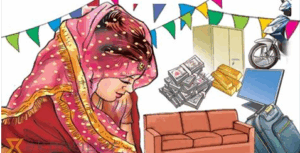
Let’s discuss socio-cultural status. Patriarchy persists as the dominant ideology under Hindu religion and culture. The constitution of the Kingdom of Nepal codified this declaring Nepal a Hindu Kingdom. The religion and its associated culture, norms and values have prevailed for hundred of years and as the result, Hindu women are more oppressed. Because of the great diversity of Nepalese society,the status of women can not be defined by Hinduism alone. These are various indigenous ethnic groups and races. Comparing to Hindu women, indigenous women have relatively better status concerning social mobility, decision making, and sexuality. But the Muslim women have the worst social status among the women belonging to different religions and cultures. The existing dowry system is to be thought to be one of the hindrances for Nepalese women. Many newly married women especially in the Terai are badly tortured by the spouse and other senior family members. The overall literacy rate of women is considerably low; only 24.7 % of Nepalese women are literate. Nepal is one of only two countries in the world where women’s life expectancy is less than that of men.
Women in politics
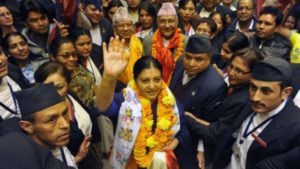
In Nepalese political status, Nepalese women have been involved in the political movement since the fifties but several factors have prevented them from actively participating in local and national politics. These factors include: the dominant ideology of patriarchy, male chauvinism, criminalization of policies, lack of equal property rights, restrictions on women’s mobility, and domination of men in all the political parties. Only few women have gained higher public positions. An encouraging trend is the presence of a lot of elected women representatives in the local bodies. This is due to the provision of seat reservation at this level. However, women lack the power to contribute significantly even within these roles as most of the resources are controlled by their male colleagues.
Status of women at present
To conclude, we can mention that Nepalese women have already opened the door to achieve the destinations of their entire freedom and rights along with their responsibilities. There is no solution to this miserable condition of Nepalese women unless they are adequately and appropriately educated concerning their rights and responsibilities.